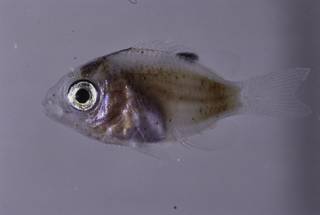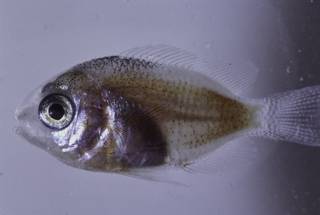WoRMS taxon details
Pomacentridae Bonaparte, 1831
- Genus Abudefduf Forsskål, 1775
- Genus Acanthochromis Gill, 1863
- Genus Altrichthys Allen, 1999
- Genus Amblyglyphidodon Bleeker, 1877
- Genus Amblypomacentrus Bleeker, 1877
- Genus Amphiprion Bloch & Schneider, 1801
- Subfamily Amphiprioninae
- Genus Azurina Jordan & McGregor, 1898
- Genus Cheiloprion Weber, 1913
- Genus Chromis Cuvier, 1814
- Genus Chrysiptera Swainson, 1839
- Genus Dascyllus Cuvier, 1829
- Genus Dischistodus Gill, 1863
- Genus Hemiglyphidodon Bleeker, 1877
- Genus Hypsypops Gill, 1861
- Genus Lepidozygus Günther, 1862
- Genus Mecaenichthys Whitley, 1929
- Genus Microspathodon Günther, 1862
- Genus Neoglyphidodon Allen, 1991
- Genus Neopomacentrus Allen, 1975
- Genus Nexilosus Heller & Snodgrass, 1903
- Genus Parma Günther, 1862
- Genus Plectroglyphidodon Fowler & Ball, 1924
- Subfamily Pomacentrinae
- Genus Pomacentrus Lacepède, 1802
- Genus Pomachromis Allen & Randall, 1974
- Genus Premnas Cuvier, 1816
- Genus Pristotis Rüppell, 1838
- Genus Pseudopomacentrus Bleeker, 1877
- Genus Pycnochromis Fowler, 1941
- Genus Similiparma Hensley, 1986
- Genus Stegastes Jenyns, 1840
- Genus Teixeirichthys Smith, 1953
- Genus Abudefdus accepted as Abudefduf Forsskål, 1775 (misspelling)
- Genus Acanthocromis accepted as Acanthochromis Gill, 1863 (misspelling)
- Genus Actinicola Fowler, 1904 accepted as Amphiprion Bloch & Schneider, 1801
- Genus Amblygliphidodon accepted as Amblyglyphidodon Bleeker, 1877 (misspelling)
- Genus Amblyglyphidon accepted as Amblyglyphidodon Bleeker, 1877 (unaccepted > misspelling - incorrect subsequent spelling)
- Genus Amblyglyphisodon accepted as Amblyglyphidodon Bleeker, 1877 (misspelling)
- Genus Ambyglyphidodon accepted as Amblyglyphidodon Bleeker, 1877 (misspelling)
- Genus Ayresia Cooper, 1863 accepted as Chromis Cuvier, 1814
- Genus Cbrysiptera accepted as Chrysiptera Swainson, 1839 (misspelling)
- Genus Chromanthias Whitley, 1935 accepted as Lepidozygus Günther, 1862
- Genus Chryseptera accepted as Chrysiptera Swainson, 1839 (unaccepted > misspelling - incorrect subsequent spelling)
- Genus Chrysipera accepted as Chrysiptera Swainson, 1839 (unaccepted > misspelling - incorrect subsequent spelling)
- Genus Chrysoptera accepted as Chrysiptera Swainson, 1839 (misspelling)
- Genus Chryspetera accepted as Chrysiptera Swainson, 1839 (unaccepted > misspelling - incorrect subsequent spelling)
- Genus Cromis accepted as Chromis Günther, 1862 accepted as Tilapia Smith, 1840 (misspelling)
- Genus Dascullus accepted as Dascyllus Cuvier, 1829 (unaccepted > misspelling - incorrect subsequent spelling)
- Genus Daya Bleeker, 1877 accepted as Pristotis Rüppell, 1838
- Genus Euchistodus accepted as Euschistodus Gill, 1862 accepted as Abudefduf Forsskål, 1775 (misspelling)
- Genus Eupomacentrus Bleeker, 1877 accepted as Stegastes Jenyns, 1840
- Genus Euschistodus Gill, 1862 accepted as Abudefduf Forsskål, 1775
- Genus Furcaria Poey, 1860 accepted as Chromis Cuvier, 1814
- Genus Gliphidodon accepted as Glyphisodon Lacepède, 1802 accepted as Abudefduf Forsskål, 1775 (misspelling)
- Genus Gliphydodon Agassiz, 1846 accepted as Glyphisodon Lacepède, 1802 accepted as Abudefduf Forsskål, 1775 (unjustified emendation)
- Genus Glyphididontops accepted as Glyphidodontops Bleeker, 1877 accepted as Chrysiptera Swainson, 1839 (misspelling)
- Genus Glyphidodontops Bleeker, 1877 accepted as Chrysiptera Swainson, 1839
- Genus Glyphidontops accepted as Glyphidodontops Bleeker, 1877 accepted as Chrysiptera Swainson, 1839 (misspelling)
- Genus Glyphisidon accepted as Glyphisodon Lacepède, 1802 accepted as Abudefduf Forsskål, 1775 (misspelling)
- Genus Heliastes Lowe, 1838 accepted as Chromis Cuvier, 1814 (synonym)
- Genus Heliazes accepted as Heliases Cuvier in Cuvier & Valenciennes, 1830 accepted as Chromis Cuvier, 1814 (misspelling)
- Genus Heptadecanthus Alleyne & Macleay, 1877 accepted as Acanthochromis Gill, 1863
- Genus Indoglyphidodon Fowler, 1944 accepted as Abudefduf Forsskål, 1775
- Genus Lutianus Cuvier, 1798 accepted as Lutjanus Bloch, 1790 (misspelling)
- Genus Nexilarius Gilbert, 1896 accepted as Abudefduf Forsskål, 1775
- Genus Oliglyphisodon Fowler, 1941 accepted as Plectroglyphidodon Fowler & Ball, 1924
- Genus Onychognathus Troschel, 1866 accepted as Chromis Cuvier, 1814
- Genus Paraglyphipodon accepted as Paraglyphidodon Bleeker, 1877 accepted as Chrysiptera Swainson, 1839 (unaccepted > misspelling - incorrect subsequent spelling)
- Genus Paramphiprion Wang, 1941 accepted as Amphiprion Bloch & Schneider, 1801
- Genus Parapomacentrus Bleeker, 1877 accepted as Pomacentrus Lacepède, 1802
- Genus Plectoglyphidodon accepted as Plectroglyphidodon Fowler & Ball, 1924 (misspelling)
- Genus Plectrogliphidodon accepted as Plectroglyphidodon Fowler & Ball, 1924 (misspelling)
- Genus Plectroglyphitodon accepted as Plectroglyphidodon Fowler & Ball, 1924 (misspelling)
- Genus Plectroglypidodon accepted as Plectroglyphidodon Fowler & Ball, 1924 (misspelling)
- Genus Pomacenteus accepted as Pomacentrus Lacepède, 1802 (misspelling)
- Genus Pomachromus accepted as Pomachromis Allen & Randall, 1974 (misspelling)
- Genus Prochilus Bleeker (ex Klein), 1864 accepted as Amphiprion Bloch & Schneider, 1801
- Genus Segastes accepted as Stegastes Jenyns, 1840 (misspelling)
- Genus Siphonochromis Fowler, 1946 accepted as Chromis Cuvier, 1814
marine, brackish, fresh, terrestrial
Not documented
Description Chiefly marine; rare in brackish water. All tropical seas, mainly Indo-Pacific. One nostril on each side of head; double...
Description Chiefly marine; rare in brackish water. All tropical seas, mainly Indo-Pacific. One nostril on each side of head; double nostrils in some species of Chromis and Dascyllus. Body usually deep and compressed. Small mouth. Incomplete and interrupted lateral line. Anal fin with usually 2 spines, very rarely 3. No palatine teeth. About 35 cm maximum length. Coloration variable with individuals and with locality for the same species. Many species are highly territorial herbivores or omnivores. Damselfishes lay elliptical demersal eggs that are guarded by the males. Included are the anemonefishes (Amphiprioninae), which live in close association with large sea anemones. Poma- = opercle, centron = spine, (refers to pointed margin of opercle); amphi- (gr.) = on both sides, prion = saw, (refers to serrate opercles) [details]
Froese, R. and D. Pauly. Editors. (2024). FishBase. Pomacentridae Bonaparte, 1831. Accessed through: World Register of Marine Species at: https://www.marinespecies.org/aphia.php?p=taxdetails&id=125553 on 2024-11-10
Date
action
by
![]() The webpage text is licensed under a Creative Commons Attribution 4.0 License
The webpage text is licensed under a Creative Commons Attribution 4.0 License
taxonomy source
Van Der Laan, R.; Eschmeyer, W. N.; Fricke, R. (2014). Family-group names of Recent fishes. <em>Zootaxa.</em> 3882(1): 1-230., available online at https://doi.org/10.11646/zootaxa.3882.1.1 [details] Available for editors  [request]
[request]
context source (PeRMS) Chirichigno, N.; Cornejo, M. (2001). Catálogo comentado de los peces marinos del Perú. <em>2ª ed. Instituto del Mar de Perú. Publicación Especial. Callao.</em> 314 p. [details]
basis of record van der Land, J.; Costello, M.J.; Zavodnik, D.; Santos, R.S.; Porteiro, F.M.; Bailly, N.; Eschmeyer, W.N.; Froese, R. (2001). Pisces, <B><I>in</I></B>: Costello, M.J. <i>et al.</i> (Ed.) (2001). <i>European register of marine species: a check-list of the marine species in Europe and a bibliography of guides to their identification. Collection Patrimoines Naturels,</i> 50: pp. 357-374 (look up in IMIS) [details]
additional source Fricke, R., Eschmeyer, W. N. & Van der Laan, R. (eds). (2024). ECoF. Eschmeyer's Catalog of Fishes: Genera, Species, References. <em>California Academy of Sciences. San Francisco.</em> Electronic version accessed dd mmm 2024., available online at http://researcharchive.calacademy.org/research/Ichthyology/catalog/fishcatmain.asp [details]
context source (PeRMS) Chirichigno, N.; Cornejo, M. (2001). Catálogo comentado de los peces marinos del Perú. <em>2ª ed. Instituto del Mar de Perú. Publicación Especial. Callao.</em> 314 p. [details]
basis of record van der Land, J.; Costello, M.J.; Zavodnik, D.; Santos, R.S.; Porteiro, F.M.; Bailly, N.; Eschmeyer, W.N.; Froese, R. (2001). Pisces, <B><I>in</I></B>: Costello, M.J. <i>et al.</i> (Ed.) (2001). <i>European register of marine species: a check-list of the marine species in Europe and a bibliography of guides to their identification. Collection Patrimoines Naturels,</i> 50: pp. 357-374 (look up in IMIS) [details]
additional source Fricke, R., Eschmeyer, W. N. & Van der Laan, R. (eds). (2024). ECoF. Eschmeyer's Catalog of Fishes: Genera, Species, References. <em>California Academy of Sciences. San Francisco.</em> Electronic version accessed dd mmm 2024., available online at http://researcharchive.calacademy.org/research/Ichthyology/catalog/fishcatmain.asp [details]
 Present
Present  Inaccurate
Inaccurate  Introduced: alien
Introduced: alien  Containing type locality
Containing type locality
Unreviewed
Description Chiefly marine; rare in brackish water. All tropical seas, mainly Indo-Pacific. One nostril on each side of head; double nostrils in some species of Chromis and Dascyllus. Body usually deep and compressed. Small mouth. Incomplete and interrupted lateral line. Anal fin with usually 2 spines, very rarely 3. No palatine teeth. About 35 cm maximum length. Coloration variable with individuals and with locality for the same species. Many species are highly territorial herbivores or omnivores. Damselfishes lay elliptical demersal eggs that are guarded by the males. Included are the anemonefishes (Amphiprioninae), which live in close association with large sea anemones. Poma- = opercle, centron = spine, (refers to pointed margin of opercle); amphi- (gr.) = on both sides, prion = saw, (refers to serrate opercles) [details]


